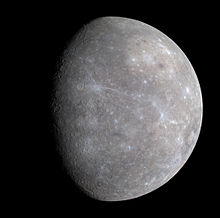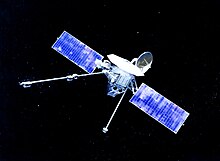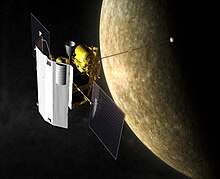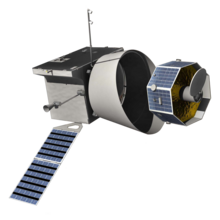Mercury (planet)
 Mercury photographed by MESSENGER spacecraft in 2008 | |||||||||||||
| Designations | |||||||||||||
|---|---|---|---|---|---|---|---|---|---|---|---|---|---|
| Pronunciation | /ˈmɜrkjəri/ ( | ||||||||||||
| Adjectives | Mercurian,[1] | ||||||||||||
| Orbital characteristics[4] | |||||||||||||
| Epoch J2000 | |||||||||||||
| Aphelion | 69,816,900 km 0.466 697 AU | ||||||||||||
| Perihelion | 46,001,200 km 0.307 499 AU | ||||||||||||
| 57,909,100 km 0.387 098 AU | |||||||||||||
| Eccentricity | 0.205 630[2] | ||||||||||||
| 87.969 1 d (0.240 846 a) | |||||||||||||
| 115.88 d[2] | |||||||||||||
Average orbital speed | 47.87 km/s[2] | ||||||||||||
| 174.796° | |||||||||||||
| Inclination | 7.005° to Ecliptic 3.38° to Sun’s equator 6.34° to Invariable plane[3] | ||||||||||||
| 48.331° | |||||||||||||
| 29.124° | |||||||||||||
| Known satellites | None diameter = 4,880 km | ||||||||||||
| Physical characteristics | |||||||||||||
Mean radius | 2,439.7 ± 1.0 km[5][6] 0.3829 Earths | ||||||||||||
| Flattening | < 0.0006[6] | ||||||||||||
| 7.48×107 km² 0.147 Earths[5] | |||||||||||||
| Volume | 6.083×1010 km³ 0.054 Earths[5] | ||||||||||||
| Mass | 3.3022×1023 kg 0.055 Earths[5] | ||||||||||||
Mean density | 5.427 g/cm³[5] | ||||||||||||
| 3.7 m/s² 0.38 g[5] | |||||||||||||
| 4.25 km/s[5] | |||||||||||||
Sidereal rotation period | 58.646 day 1407.5 h[5] | ||||||||||||
Equatorial rotation velocity | 10.892 km/h (3.026 m/s) | ||||||||||||
| 2.11′ ± 0.1′[7] | |||||||||||||
North pole right ascension | 18 h 44 min 2 s 281.01°[2] | ||||||||||||
North pole declination | 61.45°[2] | ||||||||||||
| Albedo | 0.119 (bond) 0.106 (geom.)[2] | ||||||||||||
| |||||||||||||
| up to −1.9[2] | |||||||||||||
| 4.5" – 13"[2] | |||||||||||||
| Atmosphere | |||||||||||||
| Composition by volume | 42% Molecular oxygen 29.0% sodium 22.0% hydrogen 6.0% helium 0.5% potassium Trace amounts of argon, nitrogen, carbon dioxide, water vapor, xenon, krypton, & neon[2] | ||||||||||||
Mercury is the smallest planet in the Solar System.[8][9][10] It is the closest planet to the sun.[11] It makes one trip around the Sun once every 87.969 days.[2][12]
Mercury is bright when we can see it from Earth. It has an apparent magnitude ranging from −2.0 to 5.5. It cannot be seen easily because it is usually too close to the Sun. Because of this, Mercury can only be seen in the morning or evening twilight[13] or when there is a solar eclipse.
Less is known about Mercury than about other planets of our Solar System. Even with telescopes only a small, bright crescent can be seen. It is also hard to put a satellite in orbit around it. Two spacecraft have visited Mercury. The first one was Mariner 10.[14] It only made a map of about 45% of the Mercury's surface from 1974 to 1975. The second is the MESSENGER spacecraft, which finished mapping Mercury in March 2013.
Mercury looks like Earth's Moon. It has many craters and smooth plains. It has no moons and little atmosphere as we know it. However, Mercury does have an extremely thin atmosphere, known as an exosphere.[11] Mercury has a large iron core. Because of this Mercury has a magnetic field about 1% as strong as that of the Earth.[15] It is a very dense planet because its core is large.
Temperature at the surface can be anywhere from about 90 to 700 K (−183 °C to 427 °C, −297 °F to 801 °F),[16] with the subsolar point being the hottest and the bottoms of craters near the poles being the coldest.
Known sightings of Mercury date back to at least the first millennium BC. Before the 4th century BC, Greek astronomers thought that Mercury was two different objects: The one that they were only able at sunrise, they called Apollo; the other one that they were only able to see at sunset, they called Hermes.[17] The English name for the planet is from the Romans, who named it after the Roman god Mercury. The symbol for Mercury is based on Hermes' staff.[18]
Even though Mercury is the closest planet to the Sun, it is not the hottest. This is because it has no greenhouse effect. The heat that the Sun gives it, quickly escapes into space. The hottest planet is Venus.[19]
Inside Mercury
[change | change source]Mercury is one of four inner planets in the Solar System. It is a terrestrial planet like Earth. It is the smallest planet in the Solar System. It has a radius of 2,439.7 km (1,516.0 mi).[2] Mercury is even smaller than some of the largest moons in the solar system, such as Ganymede, the largest moon of Jupiter and Titan, the largest moon of Saturn. However, it has in 2.2 times greater mass than Ganymede and around 2 times heavier than Titan. Mercury is made of about 70% metallic and 30% silicate material.[20] Mercury has the second highest density in the Solar System at 5.427 g/cm³, only a little bit less than Earth’s.[2]
Surface of Mercury
[change | change source]Mercury's surface looks like the surface of the Moon. It has plains that look like mares and has lots of craters.[21] Mercury was hit by a lot of comets and asteroids 4.6 billion years ago. Mercury was also hit during a period called the Late Heavy Bombardment.[22] Mercury has many craters because its atmosphere is too faint to slow objects down.[23] Images from MESSENGER have shown that Mercury may have shield volcanoes.[24]
The surface temperature of Mercury ranges from 100 to 700 K (−173 to 427 °C; −280 to 800 °F) at the most extreme places.[25] Even though the temperature at the surface of Mercury in the day is very high, observations suggest that there is frozen water on Mercury.[26]
Mercury is too small and hot for its gravity to keep any thick atmosphere for a long time. It does have a thin exosphere that is made up of hydrogen, helium, oxygen, sodium, calcium, potassium.[27][28] This exosphere is blown away and replenished from lots of sources. Hydrogen and helium may come from the solar wind. Radioactive decay of elements inside the crust of Mercury is another source of helium, and also sodium and potassium.[29]
Orbit and rotation
[change | change source]
Mercury has the most eccentric orbit of all the planets in the Solar System. It has an eccentricity of 0.21. It ranges from 46,000,000 to 70,000,000 km (29,000,000 to 43,000,000 mi) away from the Sun. Mercury takes 87.969 Earth days to go around the Sun.[30] Mercury's axial tilt is 0.027 degrees.[31][32]
In the future, because Mercury's orbit's is very eccentric and Jupiter's huge gravity, its orbit may become unstable and the following things may happen:
- It crashes into the Sun
- It enters the Sun's Roche limit slowly and is torn apart
- It crashes into Venus
- It crashes into Earth
- It is flung out of the Solar System and becomes a rogue planet
List of satellites sent to Mercury
[change | change source]Few man-made satellites have been sent to Mercury to study it. They are:
Mariner 10
[change | change source]
The first spacecraft to visit Mercury was NASA's Mariner 10. It stayed in Mercury's orbit from 1974 to 1975.[33] Mariner 10 took the first close-up pictures of Mercury's surface. It showed many features, such as the craters.[34] Unfortunately, the same side of Mercury was day each time Mariner 10 flew close to Mercury. This made observing of both sides of Mercury impossible. In the end, less than 45% of the Mercury's surface was mapped.[35][36]
Mariner 10 came close to Mercury three times.[37] At the first time, it found a magnetic field, which surprised planetary geologists because Mercury's rotation was too slow to create a magnetic field. The second time was mainly used to take pictures of Mercury's surface. At the third time, it got more information about the magnetic field. It showed that the Mercury's magnetic field is like the Earth's magnetic field.[38][39]
On March 24, 1975, eight days after its last close fly by, Mariner 10 ran out of fuel. Because its orbit could no longer be controlled, mission controllers shut down the probe .[40] Mariner 10 is thought to still be orbiting the Sun.[41]
MESSENGER
[change | change source]
The second satellite to visit Mercury is NASA's MESSENGER. It stands for MErcury Surface, Space ENvironment, GEochemistry, and Ranging. It was launched on August 3, 2004. It made a fly-by of Earth in August 2005. It made another fly-by of Venus in October 2006.[42] It made its first fly-by of Mercury happened on January 14, 2008, a second on October 6, 2008, and a third on September 29, 2009.[43][44] It made a map of most of Mercury that Mariner 10 didn't map. The first image of Mercury orbiting the Sun was gotten on March 29, 2011.[43]
MESSENGER was made to study Mercury's high density, the history of Mercury's geology, its magnetic field, the structure of its core, if it has ice at its poles, and where its thin atmosphere comes from. MESSENGER crashed into Mercury's surface on April 30, 2015.[45][46][47]
Bepicolombo
[change | change source]
The European Space Agency and the Japanese Space Agency made and launched a spacecraft called BepiColombo. It will orbit Mercury with two probes: one to map the planet and the other to study its magnetosphere.[48] It was launched on October 20, 2018. BepiColombo is expected to reach Mercury in 2025.[49] It will release the probe that will study the magnetosphere into an elliptical orbit. It will then release the probe the will make a map of Mercury into a circular orbit.[48]
Related pages
[change | change source]References
[change | change source]- ↑ "Mercurian". Oxford University Press. Archived from the original on 2016-12-20. Retrieved 2016-12-15.
- ↑ 2.00 2.01 2.02 2.03 2.04 2.05 2.06 2.07 2.08 2.09 2.10 2.11 "Mercury Fact Sheet". NASA Goddard Space Flight Center. November 30, 2007. Archived from the original on 2015-11-06. Retrieved 2008-05-28.
- ↑ "The MeanPlane (Invariable plane) of the Solar System passing through the barycenter". 2009-04-03. Archived from the original on 2009-05-14. Retrieved 2009-04-03. (produced with Solex 10 Archived 2003-04-13 at Archive.today written by Aldo Vitagliano; see also Invariable plane)
- ↑ Yeomans, Donald K. (April 7, 2008). "HORIZONS System". NASA JPL. Archived from the original on 2020-05-23. Retrieved 2008-04-07.
- ↑ 5.0 5.1 5.2 5.3 5.4 5.5 5.6 5.7 Munsell, Kirk; Smith, Harman; Harvey, Samantha (May 28, 2009). "Mercury: Facts & Figures". Solar System Exploration. NASA. Archived from the original on 2002-11-19. Retrieved 2008-04-07.
{{cite web}}: CS1 maint: multiple names: authors list (link) - ↑ 6.0 6.1 Seidelmann, P. Kenneth; Archinal, B. A.; A’hearn, M. F.; et al. (2007). "Report of the IAU/IAGWorking Group on cartographic coordinates and rotational elements: 2006". Celestial Mechanics and Dynamical Astronomy. 90 (3): 155–180. Bibcode:2007CeMDA..98..155S. doi:10.1007/s10569-007-9072-y. ISSN 0923-2958. S2CID 122772353. Archived from the original on 2019-05-19. Retrieved 2007-08-28.
{{cite journal}}: CS1 maint: multiple names: authors list (link) - ↑ Margot, L.J. (2007). "Large Longitude Libration of Mercury Reveals a Molten Core". Science. 316 (5825). Peale, S.J.; Jurgens, R.F.; Slade, M.A.; Holin, I.V.: 710–714. Bibcode:2007Sci...316..710M. doi:10.1126/science.1140514. PMID 17478713. S2CID 8863681. Archived from the original on 2017-09-02. Retrieved 2009-08-03.
- ↑ "Mercury Facts | Information, History, Location, Size & Definition". nineplanets.org. July 2020 [last update]. Archived from the original on 24 November 2015. Retrieved 17 August 2020.
- ↑ "BBC Solar System - Mercury: A tortured world close to our blazing Sun". bbc.co.uk. 2012 [last update]. Archived from the original on 1 October 2011. Retrieved 7 March 2012.
- ↑ Pluto used to be the smallest, but, as of 2006, Pluto is now known as a dwarf planet.
- ↑ 11.0 11.1 Murchie, Scott L.; Vervack Jr., Ronald J.; Anderson, Brian J. (March 2011), "Space Science: Journey to the Innermost Planet", Scientific American, vol. 304, no. 3, New York, pp. 26–31
- ↑ "Venus year is 224". Archived from the original on 2010-06-07. Retrieved 2010-08-26.
- ↑ How it Works Book of Space. Imagine Publishing. 2010. p. 36-37. ISBN 9781906078829.
- ↑ "NASA - NSSDC - Spacecraft - Details". Archived from the original on 2009-07-30. Retrieved 2010-08-26.
- ↑ "Mercury magnetic field". C. T. Russell & J. G. Luhmann. Archived from the original on 2010-07-19. Retrieved 2007-03-16.
- ↑ "Background Science". European Space Agency. Archived from the original on 2010-01-17. Retrieved 2008-05-23.
- ↑ Dunne, J. A. and Burgess, E. (1978). "Chapter One". The Voyage of Mariner 10 — Mission to Venus and Mercury. NASA History Office. Archived from the original on 2011-05-24. Retrieved 2009-08-03.
{{cite book}}: CS1 maint: multiple names: authors list (link) - ↑ Duncan, John Charles (1946). Astronomy: A Textbook. Harper & Brothers. pp. 125.
The symbol for Mercury represents the Caduceus, a wand with two serpents twined around it, which was carried by the messenger of the gods.
- ↑ "CBBC Newsround". British Broadcasting Corporation. Archived from the original on February 24, 2012. Retrieved February 4, 2012.
- ↑ Strom, Strom, Robert G.; Sprague, Ann L. (2003). Exploring Mercury: The Iron Planet. Springer. p. 52. ISBN 1852337311.
{{cite book}}: CS1 maint: multiple names: authors list (link) - ↑ "Mercury's Core Molten, Radar Study Shows". www.nrao.edu. Archived from the original on 2018-06-16. Retrieved 2020-09-12.
- ↑ Strom, RobertG. (1979). "Mercury: A post-Mariner 10 assessment". Space Science Reviews. 24 (1): 3. Bibcode:1979SSRv...24....3S. doi:10.1007/BF00221842. ISSN 0038-6308. S2CID 122563809. Archived from the original on 2022-05-26. Retrieved 2020-09-12.
- ↑ Broadfoot, A. L.; Kumar, S.; Belton, M. J. S.; McElroy, M. B. (1974-07-12). "Mercury's Atmosphere from Mariner 10: Preliminary Results". Science. 185 (4146): 166–169. Bibcode:1974Sci...185..166B. doi:10.1126/science.185.4146.166. ISSN 0036-8075. PMID 17810510. S2CID 7790470. Archived from the original on 2022-05-26. Retrieved 2020-09-12.
- ↑ Kerber, Laura; Head, James W.; Solomon, Sean C.; Murchie, Scott L.; Blewett, David T.; Wilson, Lionel (2009). "Explosive volcanic eruptions on Mercury: Eruption conditions, magma volatile content, and implications for interior volatile abundances". Earth and Planetary Science Letters. 285 (3–4): 263–271. Bibcode:2009E&PSL.285..263K. doi:10.1016/j.epsl.2009.04.037. Archived from the original on 2022-05-26. Retrieved 2020-09-12.
- ↑ Vasavada, A (1999). "Near-surface temperatures on Mercury and the Moon and the stability of polar ice deposits". Icarus. 141 (2): 179–193. Bibcode:1999Icar..141..179V. doi:10.1006/icar.1999.6175. Archived from the original on 2020-09-20. Retrieved 2020-09-12.
- ↑ Ingersoll, Andrew P.; Svitek, Tomas; Murray, Bruce C. (1992). "Stability of polar frosts in spherical bowl-shaped craters on the Moon, Mercury, and Mars". Icarus. 100 (1): 40–47. Bibcode:1992Icar..100...40I. doi:10.1016/0019-1035(92)90016-Z. Archived from the original on 2020-11-05. Retrieved 2020-09-12.
- ↑ Domingue, Deborah L.; Koehn, Patrick L.; Killen, Rosemary M.; Sprague, Ann L.; Sarantos, Menelaos; Cheng, Andrew F.; Bradley, Eric T.; McClintock, William E. (2007). "Mercury's Atmosphere: A Surface-Bounded Exosphere". Space Science Reviews. 131 (1–4): 161–186. Bibcode:2007SSRv..131..161D. doi:10.1007/s11214-007-9260-9. ISSN 0038-6308. S2CID 121301247. Archived from the original on 2022-05-26. Retrieved 2020-09-12.
- ↑ "Mercury Fact Sheet". 2015-11-06. Archived from the original on 2015-11-06. Retrieved 2020-09-12.
- ↑ Mercury. Vilas, Faith., Chapman, Clark R., Matthews, Mildred Shapley., American Astronomical Society. Division for Planetary Sciences., International Astronomical Union. Commission 16., Mercury Conference (1986 : Tucson, Ariz.). Tucson: University of Arizona Press. 1988. ISBN 0-8165-1085-7. OCLC 18557585. Retrieved 2020-09-12.
{{cite book}}: CS1 maint: others (link) - ↑ Van Hoolst, T. (2003). "Mercury's tides and interior structure". Journal of Geophysical Research. 108 (E11): 5121. Bibcode:2003JGRE..108.5121V. doi:10.1029/2003JE002126. ISSN 0148-0227.[permanent dead link]
- ↑ Biswas, S. (Sukumar) (2000). Cosmic perspectives in space physics. Dordrecht: Kluwer. ISBN 0-7923-5813-9. OCLC 41319901. Retrieved 2020-09-12.
- ↑ Margot, J. L.; Peale, S. J.; Jurgens, R. F.; Slade, M. A.; Holin, I. V. (2007-05-04). "Large Longitude Libration of Mercury Reveals a Molten Core". Science. 316 (5825): 710–714. Bibcode:2007Sci...316..710M. doi:10.1126/science.1140514. ISSN 0036-8075. PMID 17478713. S2CID 8863681. Archived from the original on 2022-05-26. Retrieved 2020-09-12.
- ↑ "ch1". history.nasa.gov. Archived from the original on 2020-08-01. Retrieved 2020-09-12.
- ↑ Science@NASA. "NASA - 2006 Transit of Mercury". www.nasa.gov. Archived from the original on 2019-04-03. Retrieved 2020-09-12.
- ↑ "ESA Science & Technology - Missions to Mercury". sci.esa.int. Archived from the original on 2020-10-26. Retrieved 2020-09-12.
- ↑ "USATODAY.com - MESSENGER to test theory of shrinking Mercury". usatoday30.usatoday.com. Archived from the original on 2011-07-26. Retrieved 2020-09-12.
- ↑ "mariner". history.nasa.gov. Archived from the original on 2017-12-25. Retrieved 2020-09-12.
- ↑ Ness, NormanF. (1978). "Mercury: Magnetic field and interior". Space Science Reviews. 21 (5): 527. Bibcode:1978SSRv...21..527N. doi:10.1007/BF00240907. ISSN 0038-6308. S2CID 120025983. Archived from the original on 2022-05-26. Retrieved 2020-09-12.
- ↑ Aharonson, Oded; Zuber, Maria T; Solomon, Sean C (2004). "Crustal remanence in an internally magnetized non-uniform shell: a possible source for Mercury's magnetic field?". Earth and Planetary Science Letters. 218 (3–4): 261–268. Bibcode:2004E&PSL.218..261A. doi:10.1016/S0012-821X(03)00682-4. Archived from the original on 2019-04-03. Retrieved 2020-09-12.
- ↑ "ch8". history.nasa.gov. Archived from the original on 2020-08-01. Retrieved 2020-09-12.
- ↑ "NASA - NSSDCA - Spacecraft - Details". nssdc.gsfc.nasa.gov. Archived from the original on 2018-09-08. Retrieved 2020-09-12.
- ↑ "MESSENGER Engine Burn Puts Spacecraft on Track for Venus". www.spaceref.com. Retrieved 2020-09-14.
- ↑ 43.0 43.1 "MESSENGER: MErcury Surface, Space ENvironment, GEochemistry, and Ranging". 2013-05-13. Archived from the original on 2013-05-13. Retrieved 2020-09-14.
- ↑ "MESSENGER Gains Critical Gravity Assist for Mercury Orbital Observations". Archived from the original on 2013-05-10. Retrieved 2020-09-14.
- ↑ March 2015, Mike Wall 29 (29 March 2015). "NASA Mercury Probe Trying to Survive for Another Month". Space.com. Archived from the original on 2020-09-19. Retrieved 2020-09-14.
{{cite web}}: CS1 maint: numeric names: authors list (link) - ↑ Chang, Kenneth (2015-04-27). "NASA's Messenger Mission Is Set to Crash Into Mercury". The New York Times. ISSN 0362-4331. Archived from the original on 2019-04-01. Retrieved 2020-09-14.
- ↑ Corum, Jonathan (2015-04-30). "Messenger's Collision Course With Mercury". The New York Times. ISSN 0362-4331. Retrieved 2020-09-14.[permanent dead link]
- ↑ 48.0 48.1 "ESA gives go-ahead to build BepiColombo". www.esa.int. Archived from the original on 2020-09-15. Retrieved 2020-09-14.
- ↑ "ESA Science & Technology - Fact Sheet". sci.esa.int. Archived from the original on 2020-09-27. Retrieved 2020-09-14.
Other websites
[change | change source]- Atlas of Mercury. NASA. 1978. SP-423. Archived from the original on 2019-10-09. Retrieved 2020-08-16.
- SolarViews.Com
- www.planetfacts.net Archived 2011-11-29 at the Wayback Machine

